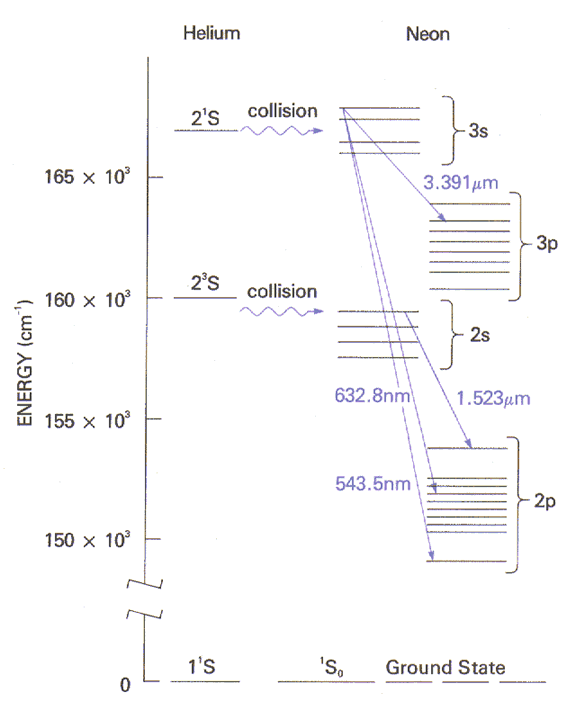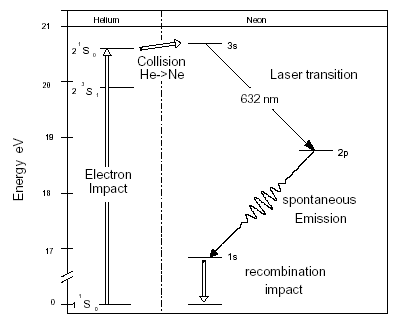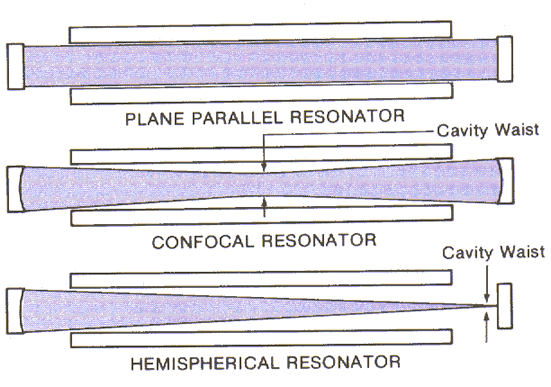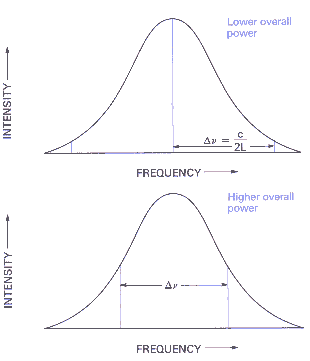Laser Systems
For many years the most common CW laser was the He-Ne laser. These low-power (mW) lasers use an electric discharge to create the population inversion. Most He-Ne laser emit in the red at 633 nm. They are used in interferometers, bar-code reader, and laser printers. They also are used for many sighting and pointing applications from medical surgery to high-energy physics.
In a helium neon laser, a low pressure mixture of helium and neon (<15%) is contained in a narrow bore glass tube. A longitudinal, DC electrical discharge is maintained in the narrow tube. This creates a plasma. Collisions with free electrons in the plasma excite the helium atoms and cause a significant number of them to be trapped in the lowest energy metastable states. These are the 21S and the 23S states, where one of the two helium electrons has been raised from the lowest energy 1S atomic orbital to the 2S orbital. For this reason, they are termed electronically excited states. Neon is a larger, more complex atom, with 10 electrons which are arranged in a 1s22s22p6 configuration in the 1S0 ground state. Neon has many excited states, and the ones concerned with laser action are shown in the energy level diagram below. The multiplet nature of the electronically excited states arises from the number of different ways in which the angular momenta of the electrons can be combined.

Two sets of excited states of neon (2s and 3s) occur at excitation energies similar to those of the 23S and 21S states of helium, which are favorably populated by the laser discharge. Within the plasma, atoms are rapidly colliding with other atoms, electrons, and with the walls of the tube. Collisions between excited state helium atoms and ground state neon atoms cause some of the neon atoms to be excited to the 2s and 3s states. Collisional energy transfer is a resonant process in which the total energy is conserved. The small energy mismatch is compensated by changes in the kinetic energy of the atoms.
Most of the neon laser wavelengths utilize transitions into the 2p series of levels. For example, the 632.8nm red output is produced by the 3s2 - 2p4 transition. The 2p energy levels lie 150000 cm-1 above the ground state and therefore are negligibly populated, even in the plasma. Consequently, a population inversion between 3s and 2p, and between 2s and 2p, in the ensemble of neon atoms in the plasma discharge is easily maintained by collisional pumping with excited helium atoms. Both the 3s - 2p and 2s - 2p transitions are optically allowed and hence can give rise to laser action. The 2p states are populated by the laser transitions but are rapidly depopulated by spontaneous emission to lower levels.

With the exception of the 3.391 micron line, helium neon lasers are all low gain devices and require cavity mirrors of high reflectance in order to achieve lasing action. Typically, one end of the cavity is defined by a total reflector (reflectance >99.9%), and the other end is defined by a mirror which permits ~ 1% of the intra cavity light to escape, forming the useful output of the laser. It therefore follows that the intra cavity beam is up to 200 times more intense than the output beam.
The 3s2 - 2p10 transition in neon at 543.5 nm is a very low gain transition. To make a green He-Ne laser this transition is made to lase in a compact plasma tube by optimizing the tube design, gas mixture, processing techniques, and cavity mirror specifications. Since prisms are not desirable in commercial helium neon lasers (for economy and stability), cavity mirrors have to meet stringent wavelength dependent specifications in order to cause amplification at 543.5 nm, while suppressing the 632.8nm line and the very high gain 3.39 micron line.
Various combinations of cavity mirror types and separations have been used with helium neon lasers.
- The simplest configuration of two plane parallel mirrors is almost never used because it produces a cavity with high diffraction losses and is very sensitive to misalignment.

- The confocal resonator uses two concave, spherical mirrors with equal radii. Each is placed at the center of curvature of the other. This cavity utilizes a large fraction of the plasma volume and produces higher power. It is much less sensitive to misalignment, but it is sensitive to exact mirror separation. The confocal resonator is rarely used when TEM00 output is required.
- The hemispherical resonator has a plane mirror at the center of curvature of a concave spherical mirror. This configuration is easy to adjust and produces highly coherent output. Such cavities are the most commonly used in commercial He-Ne lasers as they yield an excellent combination of good power, ease of adjustment, stability once aligned and good mode control.
A gas laser transition does not produce an infinitesimally narrow line. Each line has a natural line width and the Doppler effect and pressure effects broadened it even more. If the Doppler effect and pressure effects dominate the line width, the it will have a smooth Gaussian profile. Red He-Ne lasers typically have a full-width-at-half-maximum (FWHM) of 1400MHz. Superimposed on the Doppler broadened gain curve is the cavity resonance function, with the mode spacing given by Df = c/2L (look at the page for more).
For an 0.5 m cavity, the mode spacing is 300MHz. The sharpness of these modes is a function of the multipass nature of the cavity and is typically 1MHz. For such a cavity, laser output therefore consists of five or six single sharp lines (FWHM 1MHz) separated by 300MHz. The relative intensity of the cavity modes is defined by the Doppler broadened gain curve. In a very short cavity (L < 0.15m), only one mode will exist and the laser output will then consist of a single frequency.
The multiple longitudinal mode structure described above gives rise to a power fluctuation phenomenon termed mode sweeping. All unstabilized helium neon lasers exhibit this effect which is due to thermal instability causing variation in the cavity length, DL. As the cavity length changes, there is a small change in mode spacing which is typically 10kHz or less under normal conditions. However, the absolute wavelength of each cavity mode is also changed by the variation in tube length by an amount Dl = (DL/L)l. Dl depends on the glass type used for the tube, but is typically ~2.5 10-3 nm/oC. In effect, the "comb" of longitudinal modes drifts with respect to the Doppler broadened line center, repeating its initial relative position in less than 1°C. Because of the Gaussian profile of the gain curve, changes in the mode "comb" position with respect to line center can cause changes in the overall power output. If the mode spacing is very small, as with a long laser tube, these changes may be very small. On the other hand, a short laser tube may have only one or two cavity modes under the Doppler profile, and the sum of their intensity is very dependent on their position on the Gaussian gain curve.

This effect is almost identical for all unstabilized commercial TEM00 tubes and is a function of cavity length. The overall amplitude fluctuations are typically a few percent.
In a simple helium neon laser with cylindrical symmetry, the output is said to be randomly polarized. Each individual cavity mode has a linear polarization at any one time. However, the overall laser output is a time varying mix of modes of different polarization. Consequently, the beam appears to be non-polarized when integrated over a fairly short period of time.
Although the beam intensity is fairly constant, if the experiment or application involves polarization dependent optics, such as beam-splitters, then large rapid amplitude fluctuations will be apparent. If this is not acceptable, a polarized helium neon laser must be used. A polarized helium neon laser has an intra cavity Brewster window which introduces sufficient loss in the s-plane of polarization (defined by the window) so that only p-polarized output is produced.
There is an interesting and sometimes useful polarization relationship between adjacent cavity modes in a randomly polarized helium neon laser. The He-Ne is a low gain amplifier with only a limited number of excited neon atoms in the 2s and 3s states. The gain saturates at a low level. As a free-run amplifier, the laser tends to oscillate only on the modes of highest gain, a process known as gain clamping. A complete quantum mechanical treatment of the problem shows that saturation occurs at higher overall levels if adjacent cavity modes are polarized perpendicular to each other. This effect is indeed observed in randomly polarized lasers.
Link:
He-Ne Lasers
Carbon dioxide lasers also use plasma discharge tubes and emit in the mid-infrared region around 10 mm. Most are CW lasers, with commercial output powers from a few watts to several kilowatts. Together with Nd:YAG lasers, CO2 lasers are the workhorses of industrial laser applications.
Link:
CO2 Lasers
Laser diodes are the most efficient lasers, directly converting electricity to laser light in a semi-conductor chip. Once limited to the near-IR, they have long been important in telecommunications. Recent developments have brought about higher powers, arrays and shorter wavelengths. The high-power devices are used in pumping diode-pumped solid-state lasers and for light materials processing applications. Visible diodes lasers are replacing He-Ne lasers as pointers and machine vision light sources. The use of gallium nitride is allowing blue laser diodes to become a commercial reality.
Links:
Diode Laser Tutorial
There is a family of neodymium-doped crystals (Nd:YAG) that emit in the near-IR when pumped with an intense light source. Both CW and pulsed versions are available, with pulsed laser repetition rates from a few hertz to hundreds of kilohertz. The kilowatt lasers are used for industrial materials processing. Typical applications of lower-power lasers include research science, surface marking and electronic trimming. These applications often use the frequency doubled or tripled output in the visible and near-UV. At low powers, diode arrays have replaced flash lamps as the pump source. These all-solid-state lasers usually are referred to as diode-pumped solid-state lasers.
Link:
Solid State Lasers
A number of titanium- and chromium-doped crystals emit over a broad range in the red and near IR. Most are of the CW type and use the visible beam from an ion or diode-pumped solid-state laser to excite the crystal. They can be used as tunable sources with extremely narrow line width, or mode-locked. Pulse durations shorter than 10 fs have been demonstrated in these mode-locked lasers. Most of the applications are in scientific research and include time-resolved spectroscopy, photochemistry and biology, and two-photon microscopy.
The excimer laser is a pulsed (up to 1 kHz) source of intense UV pulses. The laser tube contains a mixture of an inert gas and a halogen. A high voltage (tens of kilovolts) pulse is used to energize the gas mix. Depending on the gas combination, emission is at several wavelengths between 157 and 348 nm. These lasers are used for photochemistry, pumping dye lasers and micro machining. They also are used for corneal reshaping to correct vision. The most important emerging application is for micro lithography to create the next generation of computer chips.
Many CW dye laser applications have switched to Ti:sapphire lasers. But for applications requiring tunable high-energy pulses, the dye laser is still the preferred choice. Dye lasers may be pumped by excimers or pulsed Nd:YAG lasers, with typical pulse durations of a few nanoseconds. Applications for pulsed dye lasers include photochemistry, spectroscopy, remote sensing and hyperspectral imaging.

